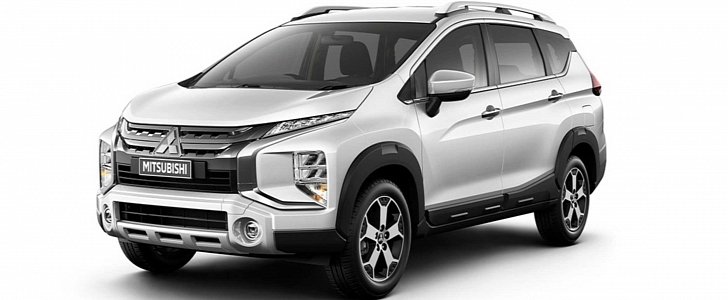Revealed in August 2017, the Xpander is an extremely important nameplate for Mitsubishi in the ASEAN region because multi-purpose vehicles are big sellers in these parts of the world. Styled to look like a crossover, the seven-seat people carrier gets even more rugged for the 2020 model year thanks to the introduction of the Xpander Cross.
Manufactured in Indonesia at the Cikarang plant in West Java, the newcomer features 20 more millimeters than the standard specification. That’s 0.8 inches and a grand total of 225 millimeters (8.8 inches) off the ground, way more than European rivals such as the Dacia Lodgy Stepway or Renault Scenic XMOD and stateside competitors as well.
Nearly two inches (50 millimeters) of fender extensions are also offered, fitting like a hand in glove with the 17-inch alloy wheels wrapped in large-profile tires, silver roof rails, and the multitude of paintwork options. Speaking of which, Sunrise Orange and Graphite Gray have been added to the palette as a means to make the Xpander more attractive.
Looking through the crossover-infused exterior design of the Xpander Cross, the interior is not great but not terrible either. 60:40 second-row seats and 50:50 third-row seats are backed up by folding armrests, cubby holes and storage areas, and quite a cavernous trunk.
The steering wheel and instrument cluster gauges might come as familiar because they’re based on the Outlander seven-seat crossover, and while the dashboard isn’t anything to go “wow” about, Mitsubishi didn’t forget about automatic climate control, a touchscreen infotainment system, and a chunky gear lever for the automatic transmission.
Customers upgrading from the five-speed manual to the torque-converter option are treated to four forward ratios, which is a joke in the day and age of 10-speed transmissions from the Ford Motor Company and General Motors. The engine isn’t particularly exciting either, a 1.5-liter naturally aspirated four-potter with 105 PS (103 horsepower) and 141 Nm (104 pound-feet) of torque sent to the front axle only. However much you’re willing to pay for such a feature, Mitsubishi can’t make a case for all-wheel drive.
Nearly two inches (50 millimeters) of fender extensions are also offered, fitting like a hand in glove with the 17-inch alloy wheels wrapped in large-profile tires, silver roof rails, and the multitude of paintwork options. Speaking of which, Sunrise Orange and Graphite Gray have been added to the palette as a means to make the Xpander more attractive.
Looking through the crossover-infused exterior design of the Xpander Cross, the interior is not great but not terrible either. 60:40 second-row seats and 50:50 third-row seats are backed up by folding armrests, cubby holes and storage areas, and quite a cavernous trunk.
The steering wheel and instrument cluster gauges might come as familiar because they’re based on the Outlander seven-seat crossover, and while the dashboard isn’t anything to go “wow” about, Mitsubishi didn’t forget about automatic climate control, a touchscreen infotainment system, and a chunky gear lever for the automatic transmission.
Customers upgrading from the five-speed manual to the torque-converter option are treated to four forward ratios, which is a joke in the day and age of 10-speed transmissions from the Ford Motor Company and General Motors. The engine isn’t particularly exciting either, a 1.5-liter naturally aspirated four-potter with 105 PS (103 horsepower) and 141 Nm (104 pound-feet) of torque sent to the front axle only. However much you’re willing to pay for such a feature, Mitsubishi can’t make a case for all-wheel drive.























